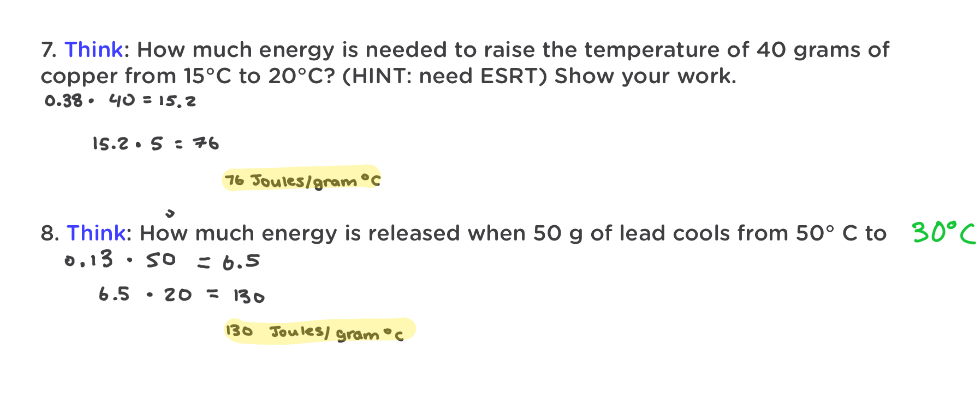How much energy is needed to raise the temperature of 40 grams of copper from 15°C to 20°C? Show your work. How much energy is released when 50 g of lead cools from 50°C to 30°C? How much energy is needed to raise the temperature of 40 grams of copper from 15°C to 20°C? Show your work. How much energy is released when 50 g of lead cools from 50°C to 30°C?

Understand the Problem
The questions are asking for calculations of energy changes in different materials based on temperature changes and mass. For the first question, it involves calculating the energy needed to heat copper, while the second question involves calculating energy released during the cooling of lead. Both questions require application of the specific heat formula.
Answer
Energy needed for copper: 76 Joules; Energy released by lead: 130 Joules.
Answer for screen readers
Energy needed to heat 40 grams of copper: 76 Joules.
Energy released when 50 grams of lead cools from 50°C to 30°C: 130 Joules.
Steps to Solve
- Identify the formula for energy change To calculate the energy required to change the temperature of a substance, we use the formula:
$$ Q = m \cdot c \cdot \Delta T $$
where:
- $Q$ = heat energy (in Joules)
- $m$ = mass (in grams)
- $c$ = specific heat capacity (in Joules per gram °C)
- $\Delta T$ = change in temperature (in °C)
- Calculate energy for heating copper Given:
- Mass of copper $m = 40 , \text{grams}$
- Specific heat capacity of copper $c = 0.38 , \text{J/g°C}$
- Initial temperature $T_i = 15°C$
- Final temperature $T_f = 20°C$
Calculate the temperature change:
$$ \Delta T = T_f - T_i = 20 - 15 = 5°C $$
Now, plug the values into the formula:
$$ Q_{\text{Cu}} = 40 \cdot 0.38 \cdot 5 $$
Calculate the energy:
$$ Q_{\text{Cu}} = 40 \cdot 1.9 = 76 \text{ Joules} $$
- Calculate energy released by cooling lead Given:
- Mass of lead $m = 50 , \text{grams}$
- Specific heat capacity of lead $c = 0.13 , \text{J/g°C}$
- Initial temperature $T_i = 50°C$
- Final temperature $T_f = 30°C$
Calculate the temperature change:
$$ \Delta T = T_f - T_i = 30 - 50 = -20°C $$
Now, plug the values into the formula:
$$ Q_{\text{Pb}} = 50 \cdot 0.13 \cdot (-20) $$
Calculate the energy:
$$ Q_{\text{Pb}} = 50 \cdot (-2.6) = -130 \text{ Joules} $$
Here, the negative sign indicates energy is being released.
Energy needed to heat 40 grams of copper: 76 Joules.
Energy released when 50 grams of lead cools from 50°C to 30°C: 130 Joules.
More Information
The specific heat capacity indicates how much energy is required to change the temperature of 1 gram of a substance by 1°C. For copper, the energy is absorbed, while for lead, the energy is released during cooling.
Tips
- Forgetting to use absolute values when calculating energy released; remember that energy released is typically expressed as a positive value.
- Not converting temperature correctly or confusing the order of final and initial temperatures.
AI-generated content may contain errors. Please verify critical information